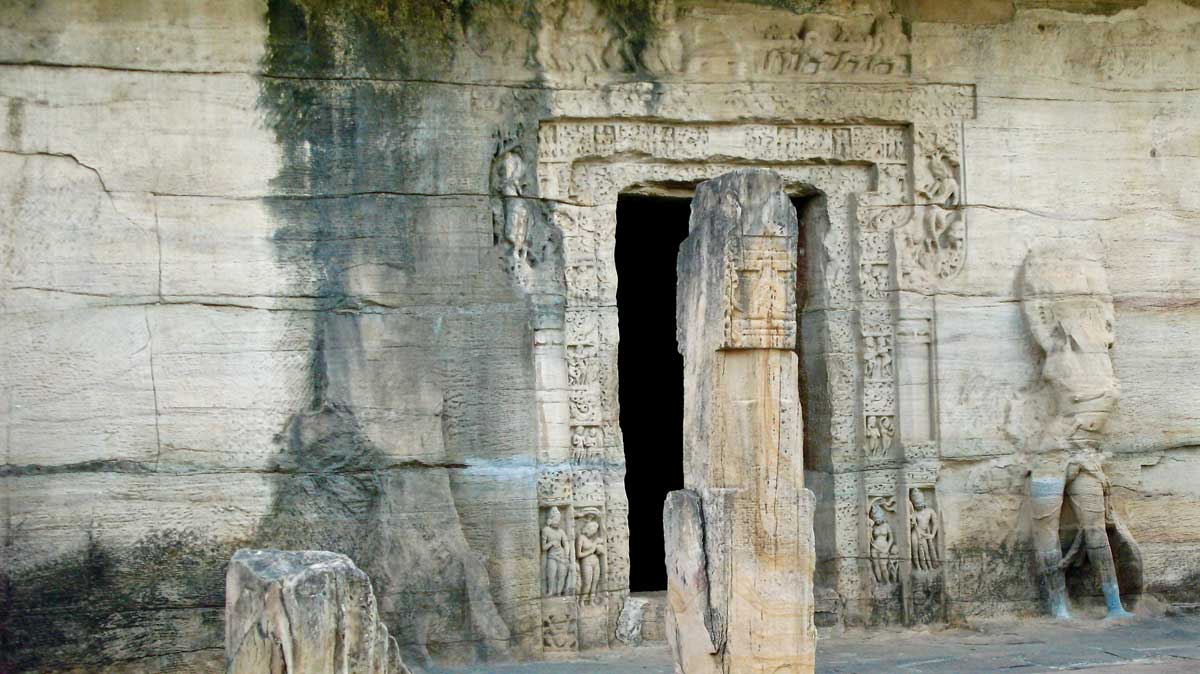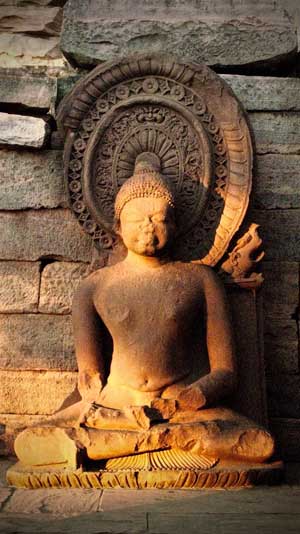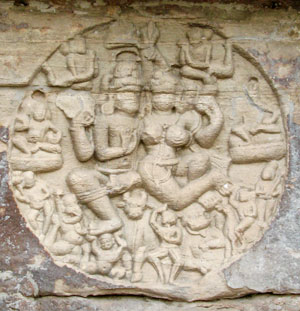Developing a Continuity of Practice
by August, 2015

Spiritual practices, such as formal meditation, chanting, pranayama, contemplation, and silent centering gain steam when the clarity, presence, and wisdom unveiled continues into the next session as if it never ended. Through such an unbroken chain, sacred connectivity begins to pervade all the moments of our life, and our old frameworks, like clouds in front of the eternal sun start evaporating faster than we so expertly create them.
A beautiful picture it is, and yet, not always the prevalent one when our limitations paint a different picture of never quite getting off the ground. As a long-time teacher and practitioner, this essay represents my thoughts – tips, if you will – that can support momentum from one sitting to the next, and in the process develop a greater tantric integration into greater wholeness.
EARLY STAGE OF PRACTICE
For the beginner, the challenges of ongoing life sometimes derail daily practice. When competing with social concerns, mood swings, work, and family; maintaining continuity can be no easy task. The first tip is to pick one and only one practice, for example a chant or a pranayama (breath exercise) that you do every day, and then do anything else on top of that for fun as you feel like it. Spiritual practices have a way of not only physically, but also emotionally and mentally detoxifying us, and to have too many demands at first can become overwhelming.
Another tip is to pick a practice that is uplifting. We could say that all practices are uplifting but, for example, a beginner might become sleepy in more subtle explorations of meditation and lose interest, whereas the vitality occurring with pranayama that follows stretching usually gives an immediate benefit. Later, as you develop the ability to consistently hold an inward focus, then the subtle practices become very fun and life changing.
Set parameters for yourself before committing to a particular practice, say for a month or two and stick to it. For example, what happens if you get home at 3 am? Do you skip practice or engage for even 5 minutes? Make it workable, not too fanatic, but also disciplined for the moments when you wonder why-am-I-doing-this. By giving yourself guidelines, then your inner-self has a framework for effecting the subtle cleansing and transformative processes of the mind and the sub-conscious.
When I first lived in an ashram in the late 70’s, one of the long-time residents said to me, “You know I see a lot of young people come and go here. The same thing happens for most of them; they start to detox and get sick, and then they miss the 4 am practice, or sleep through it, and they never get back on track.” Now this guy had some presence, some gravitas, and I felt he was doing something right. I really took what he said to heart, and for the first year vowed never to let my head touch the ground. Sure enough, as I went through a detox, the laughable bobbing of my head and body trying to stay awake was surely not meditation, but it developed stamina which later served me tremendously. The daily kirtan (chanting and devotional singing to music) following the group sadhana was my reward, and I could not even speak of the bliss it gave me.
AJAPA
Once an initial practice has so solidified that you are hooked, you might want to give ‘japa/ajapa’ a try. Here, you choose or are given one mantra that resonates with you, and you repeat it continually throughout the hours of the day, for a considerable length of time, say a year, whereupon it becomes the background shimmering in your awareness. At times it comes into the foreground as the only awareness, such as when sitting.
Some examples are the Gayatri mantra, On Namo Bhagavate, Om Namah Shiva(ya), among many others. Mantra recitation awakens you very powerfully to that which does not sleep, and for some practitioners, it is the glue that holds their practice together during the ‘dry’ intervals.
IN THE MOOD

No doubt about it, spiritual states require a more rarified atmosphere so that it can be perceived and understood. Part of maintaining a continuity of practice is to keep your mind stream elevated. Reading stories of saints and how other practitioners have overcome the challenges in front of them, keeps one in the mood, and is fun. Having like-minded friends, visiting sacred places, and if you are so fortunate to have a spiritual teacher, their inspiration and wisdom are like gold.
Communicate with yourself. Ask, “hmm, I wonder how my pranayama is going to like that second serving of chocolate cake?” It is not about the chocolate cake, it is about the specialness of your practice and intentions; in this way you maintain a positive current.
WHAT DO YOU WANT?
In 35 years of teaching, I have learned to ask people at the beginning of their journey, and then again at various times, “What is it that you want?” This is important, because there is a ripeness to sincere spiritual practice. For those who are ripe, it is not an entertainment, it becomes a necessity. If you recognize that this is your time, then you can really come to terms with it and embrace it fully!
Often this is a difficult question, because until we gain experience, the value of sadhana is difficult to articulate, and we craftily use concepts we have read or heard, such as enlightenment, liberation, great bliss, etc. Still, it is good to ask and reflect upon this honestly. It helps to acknowledge the pull rising from an inner place, and bring that into the relationship. Even a glimmer helps in the process of getting there by being there.
THE LITTLE THINGS
So if we practice 30 minutes, 1 hour, 2 hours, 5 hours in a day, that still leaves a lot of other hours in the day. A great secret is not to just focus on the big moments, but on all the little ones. Have an inspiring picture in your work area, and take a moment here or there to remember your mantra. If you catch yourself in a funk and change a thought to an elevating one, send a good thought someone’s way, and remember the positive moments, then all of these together help to create a continuity. This cannot be overemphasized, and the bloom you experience in your practice carries over into your daily life.
A FRAMEWORK
Sometimes the seeker may stumble into spiritual practices without really giving much thought as to how they exist as part of a larger framework, and not knowing better, may isolate these practices from a more expanded context. For example, we pick up a chant, or start moving into the spiritual side of martial arts. This works fine in the beginning, but we can quickly get ourselves in over our head, as we start to activate our energy.
A number of practitioners throughout the ages have collectively created various frameworks in which practices, written knowledge, lifestyle, and different types of transmission work together to support an overall transformation, with the common goal of achieving great clarity. There are different approaches, each geared to individuals with different characteristics. It takes some searching to discover these resources, but it is well worth it.
A TEACHER
Traditionally, a teacher or a lineage has always been an important part of this equation. There are some who have developed the ability to have these relationships on a non-physical level, but most need the physical connection as an anchor, which when given permission, can challenge us in areas we might otherwise avoid, as well as help give a voice to our own inner voice. The primary job of a teacher-student relationship, as it matures, is to return a student to themselves; but it is also one of the great joys of life because of the inner connection.
A teacher is a vehicle of transmission, which can be defined as getting a taste of what a heightened state feels like, which you then cultivate for yourself. A teacher can at critical moments give feedback and protection in subtle arenas; however, they are not a substitute for your own sadhana.
TWICE PER DAY
Meditate at least twice a day. Even if you are exhausted in the evening after a long day’s work, at least sit for a couple of minutes. Make this a habit. In the end there is no one to complain to. And after a while it becomes a love affair.
RETREAT

For most of us it is a dance as to how much time we get for personal sadhana in relation to our overall life. Hence, it becomes really important to schedule at least one or two retreats in a year, where you can go into deep practice for many hours of the day. In the days leading up to your retreat, further refine your diet, and if possible lengthen your practice. On retreat, outside of your practice, take as much rest as needed.
A TIP TO REMEMBER
Say you have an enlightening moment, or a special realization during your morning sitting, something you really want to carry forth and not forget.
Go to a point 3 or 4 inches above your head, while maintaining bodily awareness. Visualize or feel yourself as a point or area of light there, and place your realization into it. Make the strong intention that the next time you sit, it will all come back in perfect clarity.
Each time when you subsequently start your practice, first touch into that place. In this way you can retain these very refined understandings to continue building upon them when you next sit. You simultaneously deepen the relationship with yourself, bringing it to more subtle levels.
MOVE ENERGY
Practice moving energy. This is key. For example, try jumping into cold lakes and rivers; not only is it refreshing, but it also give us practice in moving from one state to another. No River, jump in a cold shower – it’s invigorating! Upset, have a grudge – go for a walk. Do some kicks, stretch, move the energy.
I have often seen enthusiastic practitioners moving like rocket ships, and then they come up against an obstacle and stop. In effect they keep their practice safely away from the crisis so that they do not really need to look at it, or rely on it, or question how their practice might help them through this challenge. It could be a job, a relationship, or a personal quirk that one becomes attached to. It takes courage, and practice moving the energy in little moments to sustain you in these big moments.
When I would arrive home from work a bit tired, I would instinctively go to the refrigerator (we used to call them ice boxes) to see what was available. I would also do a few pushups against the counter top, then look again, and do some squats or a few kicks. I would say, “oh I will sit for a moment,” and then start a practice (rather than eating first thing). Not fighting against the energy, I would rather transform it through movement. This strategy becomes an important skill in maintaining a clear focus of what we want, and it is constructed through these little moments.
RELATIONSHIP

If I were to pick one word as a substitute for the word ‘spiritual’, it would be ‘relationship.’ Here, I am talking about the vastness of subtle, interior relationship. When it dawns on us that we are always in relationship with life, with everyone, we can begin to cultivate our thoughts more carefully and consequently, we pay attention to our environment. As we develop the richness of inner relationship, it becomes our springboard to greater spiritual practice. Sadhana is not just about developing sensitivity, but also the strength to support that refined sensibility.
Think about it, entering into the body of the one, is entering into relationship with all of those who are awake in the body of the one. So how better to enter that than through cultivating such a relationship?
Beings such as Krishna, Shiva, Tara, Vajra Yogini, etc., become very real.
Prior to this, practices such as the refinement of posture, incorporating longer mantras, breath work, and developing the inner relationship, all bring you to that tantric place.
Beings such as Krishna, Shiva, Tara, Vajra Yogini, etc., become very real. Have an altar, and when you travel, set up a makeshift altar in a hotel room, or even a picture next to your sleeping bag. Relationship, and the love within that builds an awareness of its continuity.
NECTAR
I have saved this aspect for the last, because it is an intermediate-to-advanced characteristic of spiritual practice. As we advance in our sadhana to the stage where we can enter deep meditation within seconds, and hold an inward focus upon subtle energies, then it becomes natural to start a practice with the elemental qualities and the nectar body. Nectar is a substance that is part physical (or very nearly physical), part subtle, and part very subtle. Thus it is a tangible substance that can help bridge the worlds within us while giving us various experiences of ecstasy and bliss. When we enter into this essence, something simple but even more profound occurs - happiness.
We first need to refine our elemental makeup so that the vitality and strength we possess can support the experience of the nectar within our very own body. Typically the practice is very simple; for example, feeling a drop of sensual nectar in the head, or a loving quality in a drop in the heart. One’s focus sustains this experience and it becomes even more real. This becomes a profound component of creating a continuity and depth within our practice.
Prior to this, practices such as the refinement of posture, incorporating longer mantras, breath work, and developing the inner relationship, all bring you to that tantric place.
CONCLUSION

As you can see, it is not one thing alone that creates a continuity, but many different aspects working together. As our practice advances we, at times, gain effortless focus and a clear, mostly thought-free, space. Through familiarity and sustained practice, this quality underlies everything, every single moment of the day. As you come to understand this as the ever-present, unchanging reality, this state in which you live becomes a vehicle beyond life and death.
With this, it becomes obvious that everything is made out of various permutations of consciousness. This awareness becomes the true continuity, for you are never outside of it. Within this, we can simultaneously remain inwardly grounded and aware of how our consciousness is independent of outer form, as a causal existence. In this, we gain great freedom and spaciousness.
This is a natural unfolding of sadhana practiced within a framework. While some may see this as the goal, many consider it to be the true beginning of the spiritual path, for you realize the vastness and beauty of who you are. In truth everything occurs in this timelessness state, which from another way of looking at it, is a continuity. Our mind, itself created of the same substance, creates the fog that conceals this from our experience.
May we all become clear and luminous. May our light be a blessed presence for all.

